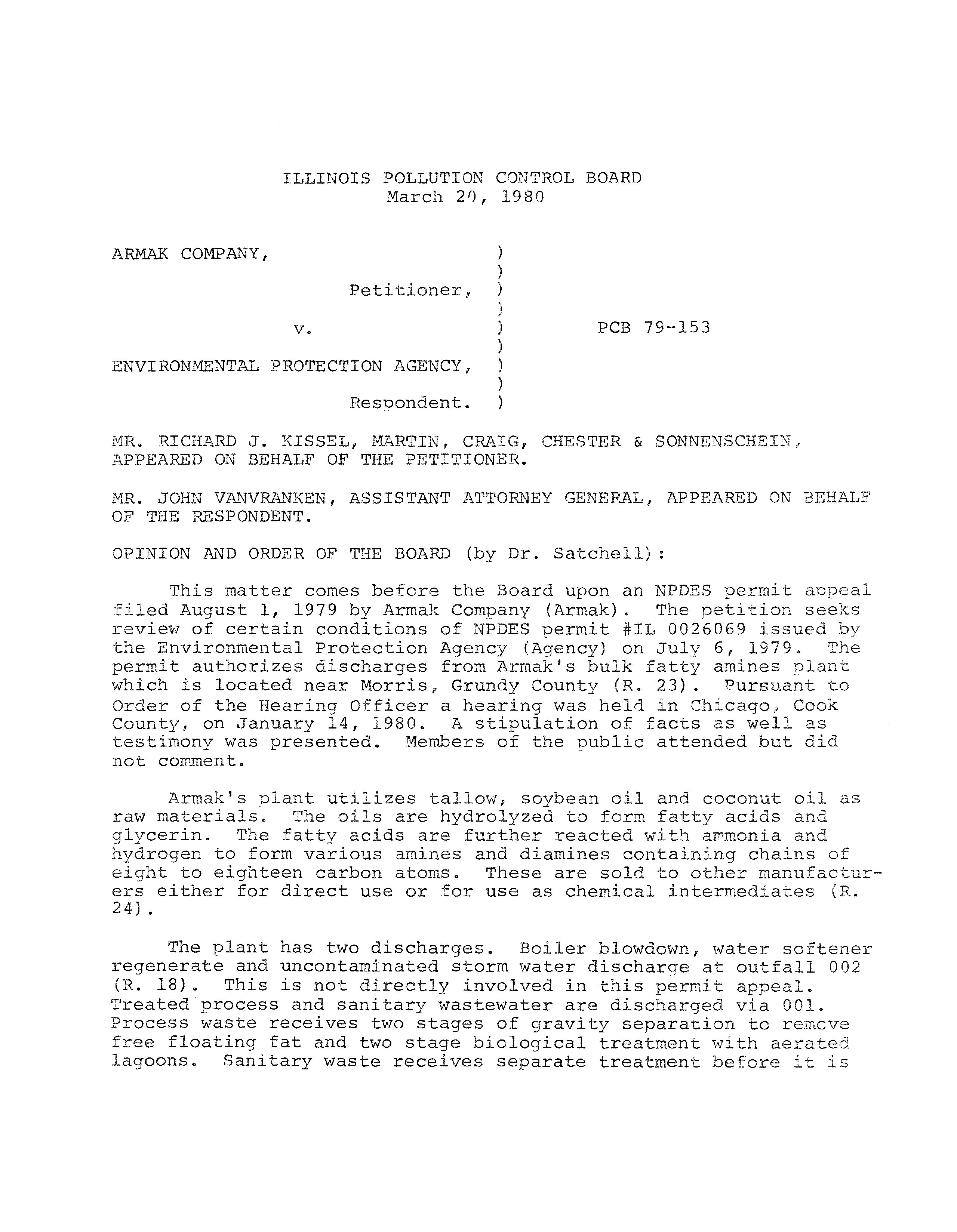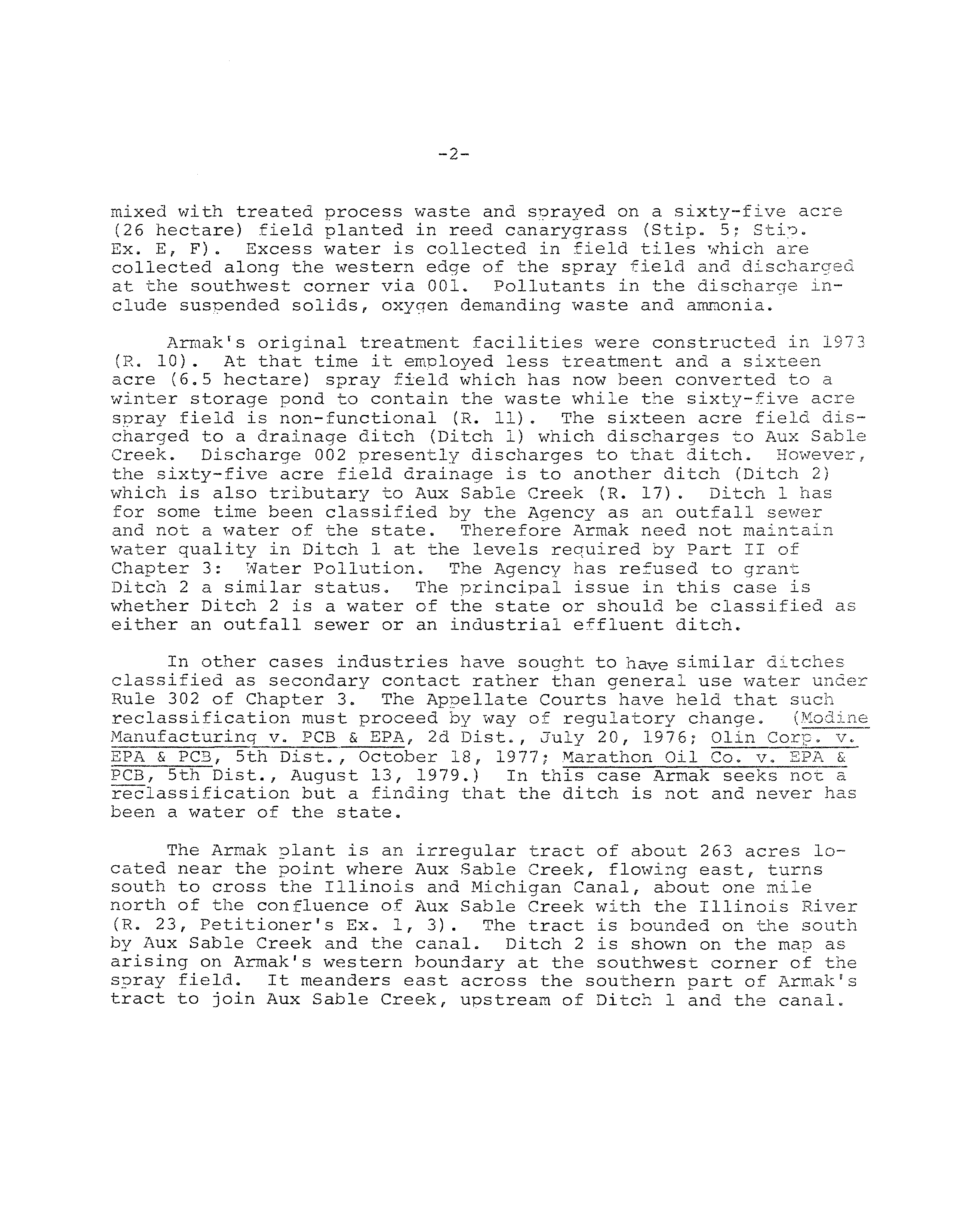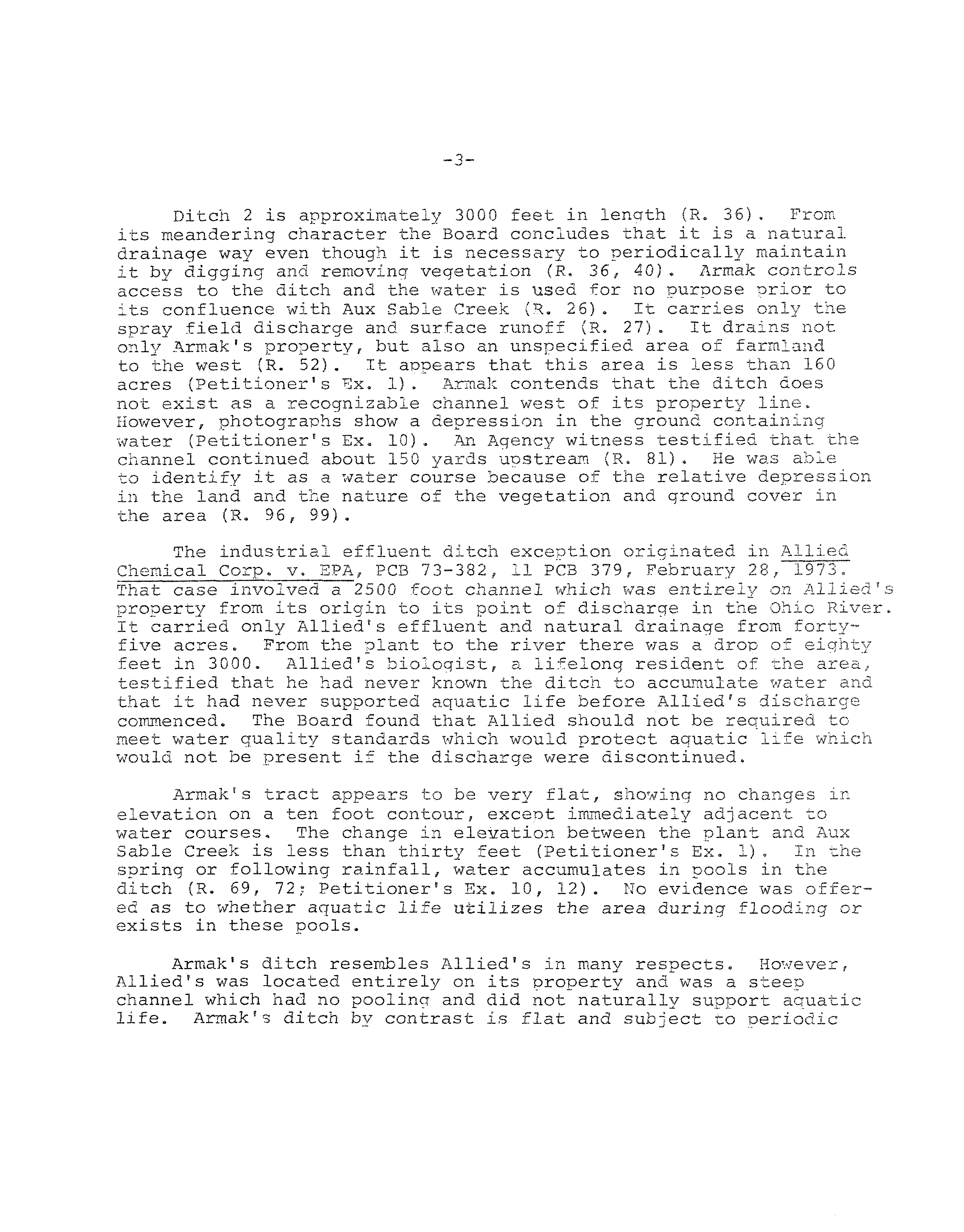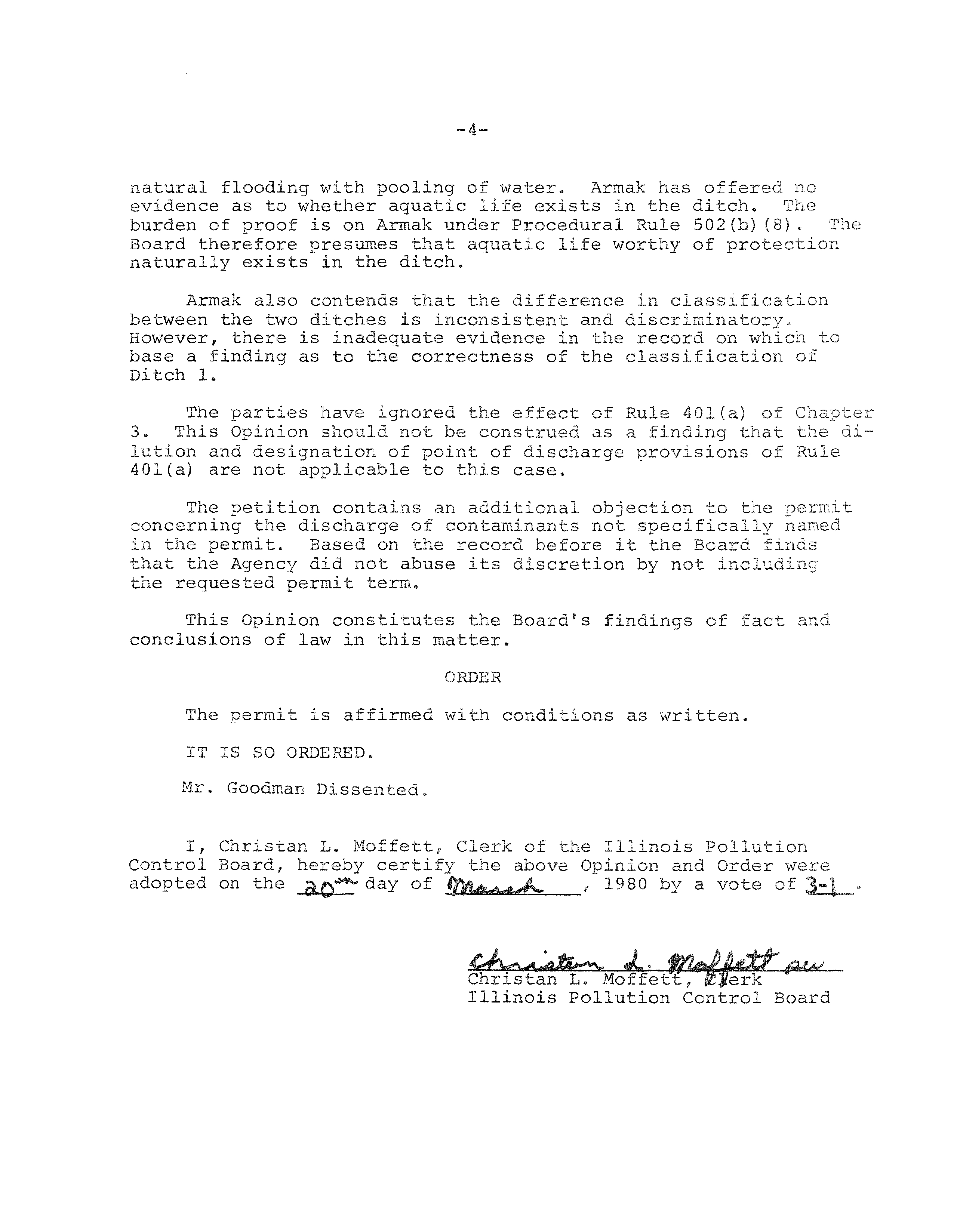ILLINOIS POLLUTION CONTROL BOARD
March
20,
1980
ARMAK
COMPANY,
Petitioner,
v.
)
PCB
79—153
ENVIRONMENTAL PROTECTION AGENCY,
)
Respondent.
MR.
RICHARD
J.
KISSEL,
MARTIN,
CRAIG, CHESTER
& SONNENSCHE:EN,
APPEARED ON BEHALF OF THE PETITIONER.
MR. JOHN VANVRANKEN, ASSISTANT ATTORNEY
GENERAL,
APPEARED ON
BEHALF
OF THE RESPONDENT.
OPINION
AND
ORDER OF THE
BOARD
(by Dr.
Satchell)
This matter comes before the Board upon an NPDES permit aupeal
filed August
1,
1979 by
Armak
Company
(Armak).
The petition seeks
review of certain conditions of NPDES permit ~IL 0026069
issued by
the Environmental Protection Agency
(Agency)
on July
6,
1979.
The
permit authorizes discharges from Armak’s bulk fatty amines plant
which is
located near Morris,
Grundy County
(R.
23)
.
Pursuant
to
Order of the Hearing Officer a hearing was held in Chicago, Cook
County,
on January
14,
1980.
A stipulation of facts as well
as
testimony was presented.
Members of the public attended but did
not comment,
Arrnak~splant utilizes tallow,
soybean oil and coconut oil
as
raw materials.
The oils are hydrolyzed to form fatty acids
and
glycerin.
The fatty acids are further reacted with ammonia and
hydrogen to form various amines and diamines containing chains
of
eight to eighteen carbon atoms.
These are sold to other manufactur-
ers either for direct use or for use
as chemical intermediates
(R.
24)
The plant has two discharges.
Boiler blowdown, water softener
regenerate and uncontaminated storm water discharge
at outfall
002
(R.
18).
This
is not directly involved in this permit appeal.
Treated’process
and sanitary wastewater are discharged via 001,
Process waste receives two stages of gravity separation to remove
free floating fat and two stage biological treatment with aerated
lagoons.
Sanitary waste receives separate treatment before
it
is
mixed with treated process waste and sprayed on a sixty-five acre
(26 hectare)
field planted in reed canarygrass
(Stip.
5: Sti~.
Ex.
E,
F),
Excess water
is collected in field tiles which are
collected along the western edge of the spray field and discharged
at the southwest corner via 001.
Pollutants
in the discharge in-
clude suspended solids, oxygen demanding waste and ammonia.
Armak~s original treatment facilities were constructed in 1973
(F.
10).
At that time it employed less treatment and a sixteen
acre
(6.5 hectare) spray field which has now been conveited to a
winter storage pond to contain the waste while the sixty-five acre
spray field is non-functional
CR.
11).
The sixteen acre field dis-
charged to
a drainage ditch
(Ditch
1) which discharges to Aux Sable
Creek,
Discharge
002 presently discharges to that ditch.
However,
the sixty-five acre field drainage
is
to another ditch
(Ditch
2)
which is also tributary to Aux Sable Creek
CR.
17).
Ditch
1 has
for some time been classified by the Agency as an outfall sewer
and not
a water of the state,
Therefore Armak need not maintain
water quality in Ditch
1 at the levels required by Part II of
Chapter
3:
Water Pollution,
The Agency has refused to grant
Ditch
2 a similar status.
The principal issue in this case is
whether Ditch
2
is
a water of the state or should be classified
as
either an outfall sewer or an industrial effluent ditch,
In other cases industries have sought to have similar ditches
classified
as secondary contact rather than general use water under
Rule 302 of Chapter
3.
The Appellate Courts have held that such
reclassification must proceed by way of regulatory change.
(Modine
Manufacturing
v. PCB&
EPA,
2d Dist,,
July 20,
1976; Olin Corp.
V.
EPA
& PCB,
5th Dist., October 18,
1977; Marathon Oil Co.
v. EPA
&
PCB,
5th Dist., August
13,
1979,)
In this case Armak
seeks not
a
reclassification but a finding that the ditch
is not and never has
been
a water of the state,
The Armak plant
is an irregular tract of about 263 acres lo-
cated near the point where Aux Sable Creek,
flowing east,
turns
south to cross the Illinois
and Michigan Canal, about one mile
north of the confluence of Aux Sable Creek with the Illinois River
(F.
23, Petitioner~sEx.
1,
3)
.
The tract
is bounded on the south
by Aux Sable Creek and the canal.
Ditch
2
is shown
on the map as
arising on Armak’s western boundary at the southwest corner of the
spray
field,
It meanders east across the southern part of Armakvs
tract to join Aux Sable Creek, upstream of Ditch
1 and the canal.
Ditch
2 is approximately 3000 feet in lenoth
(F.
36)
.
From
its meandering character the Board concludes that it is a
natural
drainage way even though it is necessary
to periodically maintain
it by digging and removing vegetation
CR.
36,
40),
Armak controls
access to the ditch and the water is used for no purpose prior to
its confluence with Aux Sable Creek
(F.
26),
It carries
only
the
spray field discharge
and. surface runoff
(F.
27)
.
It drains not
only Armak~sproperty, but also an unspecified area of
farmland
to the west
(F.
52).
It. appears that this area is less
than
160
acres
(Petitioner~sEx.
1).
Armak
contends that the ditch does
not exist as
a recognizable channel west of its property line.
However, photographs show a depression in the ground containing
water
(Petitioner~sEx.
10).
An Agency witness testified that
the
channel continued about
150 yards upstream
(F.
81).
He
was
anle
to identify it as
a. water course because
of the relative depression
in
the land and the nature of the vegetation and ground cover
in
the area
(F,
96, 99).
The
industrial
effluent
ditch
exception
originated
in
Allied
Chemical
Corp.
v.
EPA,
PCB
73-382,
Ii
PCB
379,
February
28,
1973,
That
case
involved
a
2500
foot
channel
which
was
entirely
o.n
A1lied~s
prooerty from its origin to its point
of
discharge
in the Ohio River.
It carried only Al1ied~seffluent and natural drainage from forty~
five acres.
From the olant to the river there
was
a
drop of
eighty
feet
in
3000.
Al1:Led~sbiologist,
a lifelong resident
of
the
area,
testified
that
he
had
never
known
the
ditch
to
accumulate
water
and
that
it
had never supported aquatic life before Allieds
discharge
commenced.
The Board found that Allied should not be required to
meet water quality standards which would protect aquatic 1~fewhich
would not be present if the discharge were discontinued.
Armak1s tract appears
to
be
very
flat, showing no changes
:Ln
elevation on a ten foot contour, exceot immediately adjacent to
water courses.
The change
in
e1e~rationbetween the plant and Aux
Sable Creek is less than thirty feet
(Petitioner~sEx,
I),
In the
spring or following rainfall, water accumulates
in pools
in the
ditch
CR.
69,
72; Petitioner~sEx.
10,
12).
No evidence was offer-
ed as
to whether aquatic life utilizes the area during flooding or
exists
in these pools.
Armak’s ditch resembles Allied~s in many respects.
However,
A1lied~swas located entirely on its property and was
a
steen
channel which had no pooling and did not naturally support aquatic
life.
ArmakTs ditch by contrast is
flat and subject to neriodic
—~1—
natural flooding with pooling of water.
Armak has offered no
evidence as to whether aquatic life exists
in the ditch.
The
burden of proof is on Armak under Procedural Rule 502(b) (8).
The
Board therefore presumes that aquatic
life worthy of protectior.
naturally exists
in the ditch.
Armak also contends
that
the
difference
in classification
between the two ditches
is inconsistent and discriminatory.
However, there is inadequate evidence in the record on which to
base a finding as
to the correctness of the classification of
Ditch
I.
The parties have ignored the effect of Rule 401(a)
of
Chapter
3,
This
Opinion
should
not
be
construed
as
a
finding
that
the
di-
lution
and
designation
of
point
of
discharge
provisions
of Rule
401(a)
are
not applicable to this case.
The petition contains an additional objection to
the
permit
concerning the discharge of contaminants not specifically
named
in
the
permit.
Based
on
the
record
before
it the Board finds
that
the Agency did not abuse
its discretion by not including
the requested permit term,
This Opinion constitutes the Board~s findings of fact and
conclusions
of law in this matter.
ORDER
The permit is affirmed with conditions
as written.
IT
IS
SO
ORDERED.
Mr. Goodman Dissented.
I, Christan L.
Moffett, Clerk of the Illinois Pollution
Control Board, hereby certify the above Opinion and Order were
adopted on the
~
day of
~
,
1980 by a vote of
3~.
~
~.
~
Christan
L.
Noffett,
~erk
Illinois Pollution Control Board




